The oil paintings of Isaac Walter Jenner (1836-1902) are executed in a fine and detailed manner which invite close and careful viewing. Like many artists, Jenner used sketching or ‘underdrawing’ to develop subjects beneath oil paint layers. Here, we...
The oil paintings of Isaac Walter Jenner (1836-1902) are executed in a fine and detailed manner which invite close and careful viewing. Like many artists, Jenner used sketching or ‘underdrawing’ to develop subjects beneath oil paint layers. Here, we highlight the artist’s style and detail some of the discoveries found when we look at Jenner’s preparation for painting using infrared reflectography (IRR imaging)1.
Infrared imaging of Jenner’s paintings show that the artist most often prepared a very careful underdrawing. Generally, this underdrawing appears detailed, confident and strong, and in some cases shows evidence of grid lines and possible tracing from a pre-prepared composition.
‘Hamilton Reach, Brisbane’ 1885
An early painting, Hamilton Reach 1885 (illustrated) provides an example of the artist’s intricate drawing preparation underneath the paint. We can see that Jenner has laid down complex outlining of the foliage, buildings and ships, however this is not explorative or sketchy, and given its confidence and evenness of line, appears to have been traced or reinforced over a sketch.
However, the artist does not always contain the final painted composition to the underdrawing outlines — as seen in Hamilton Reach, in the way the tree on the far left does not align with the outlines of the preparation. Here the final painted composition of the tree appears in IRR imaging as a darker shadowy image — Jenner has decided to paint the tree larger in size than his under sketch.
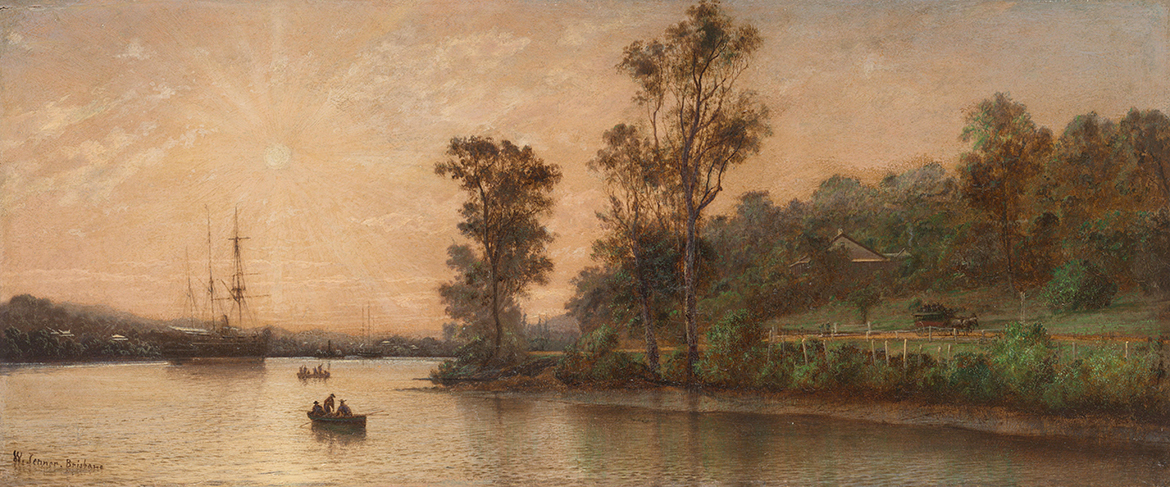 Isaac Walter Jenner, England/Australia 1836-1902 / Hamilton Reach, Brisbane 1885 / Oil on wood panel / 21.7 x 52.4cm / Purchased 1986 / Collection: Queensland Art Gallery | Gallery of Modern Art
Isaac Walter Jenner, England/Australia 1836-1902 / Hamilton Reach, Brisbane 1885 / Oil on wood panel / 21.7 x 52.4cm / Purchased 1986 / Collection: Queensland Art Gallery | Gallery of Modern Art
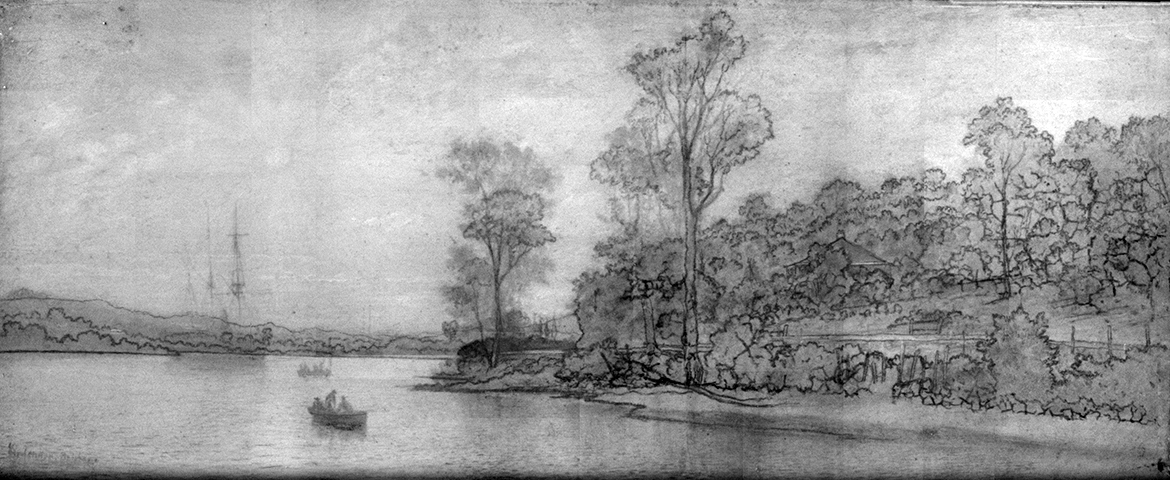 Infrared reflectography (IRR) composite of Isaac Walter Jenner’s Hamilton Reach, Brisbane 1885
Infrared reflectography (IRR) composite of Isaac Walter Jenner’s Hamilton Reach, Brisbane 1885
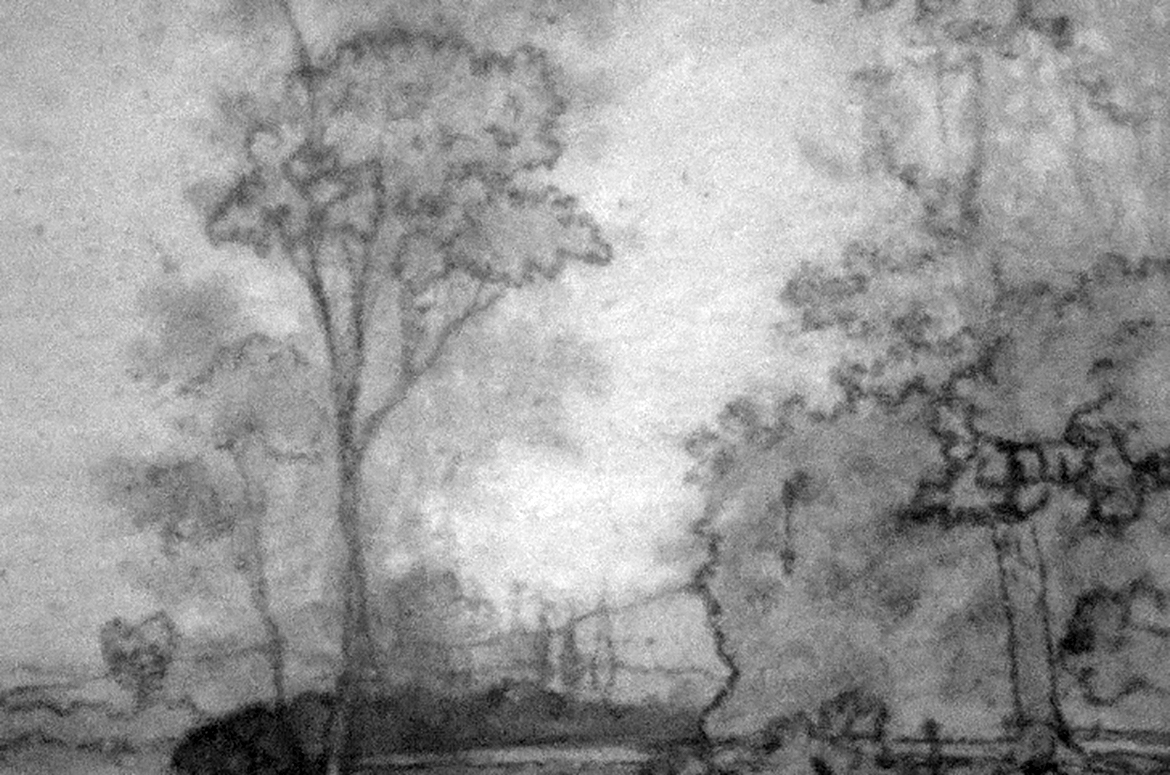 Infrared reflectography (IRR) composite detail illustrating added painted composition which differs to the underdrawing in Isaac Walter Jenner’s Hamilton Reach, Brisbane 1885
Infrared reflectography (IRR) composite detail illustrating added painted composition which differs to the underdrawing in Isaac Walter Jenner’s Hamilton Reach, Brisbane 1885
‘Queensland natives, the Currigee Oyster Company’s Station, Stradbroke Island, Moreton Bay’ 1897
Queensland natives, the Currigee Oyster Company’s Station, Stradbroke Island, Moreton Bay 1897 (illustrated) is one of Jenner’s later paintings. It again shows beautifully resolved and confident underdrawing, especially of the distant mountain range.
Details of this painting taken at high magnification — with the camera closer to the artwork — indicate that lines may have been traced from a previous drawing and later reinforced with a hard drawing medium.
You can see in the detail of the mountain ranges where the bold drawing medium sits on top of finer underdrawing lines indicating an initial soft sketch later reinforced.
Similarly, the figures on the raft appear to have had their underdrawing reinforced.
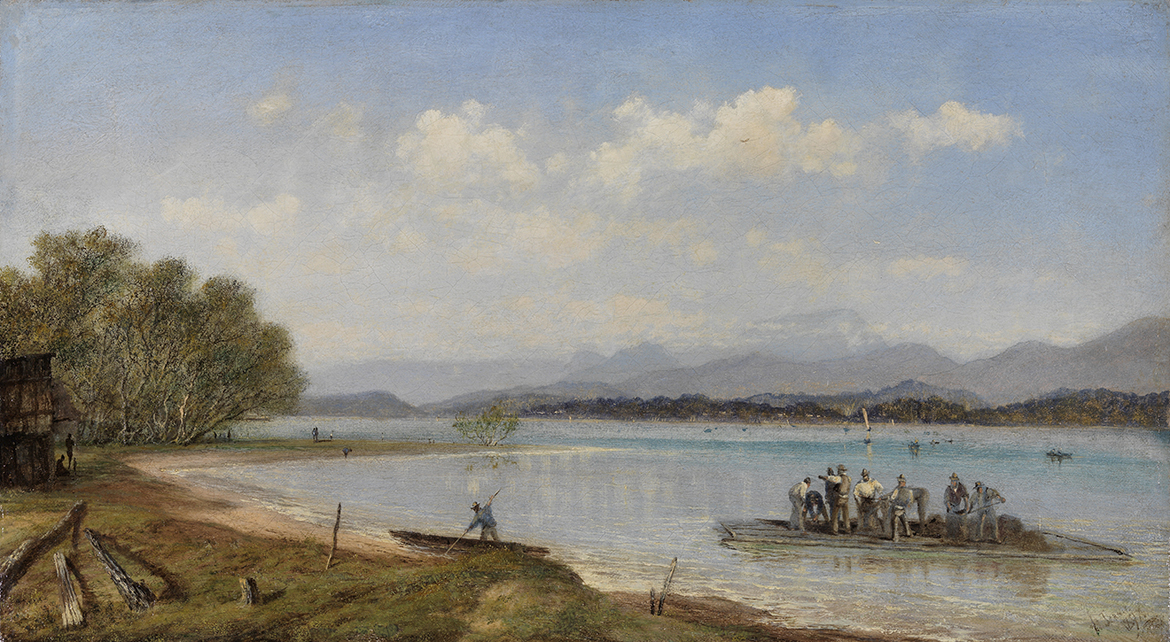 Isaac Walter Jenner, England/Australia 1836–1902 / Queensland natives, the Currigee Oyster Company’s Station, Stradbroke Island, Moreton Bay 1897 / Oil on canvas / 25 x 46cm / Purchased 1990 / Collection: Queensland Art Gallery | Gallery of Modern Art
Isaac Walter Jenner, England/Australia 1836–1902 / Queensland natives, the Currigee Oyster Company’s Station, Stradbroke Island, Moreton Bay 1897 / Oil on canvas / 25 x 46cm / Purchased 1990 / Collection: Queensland Art Gallery | Gallery of Modern Art
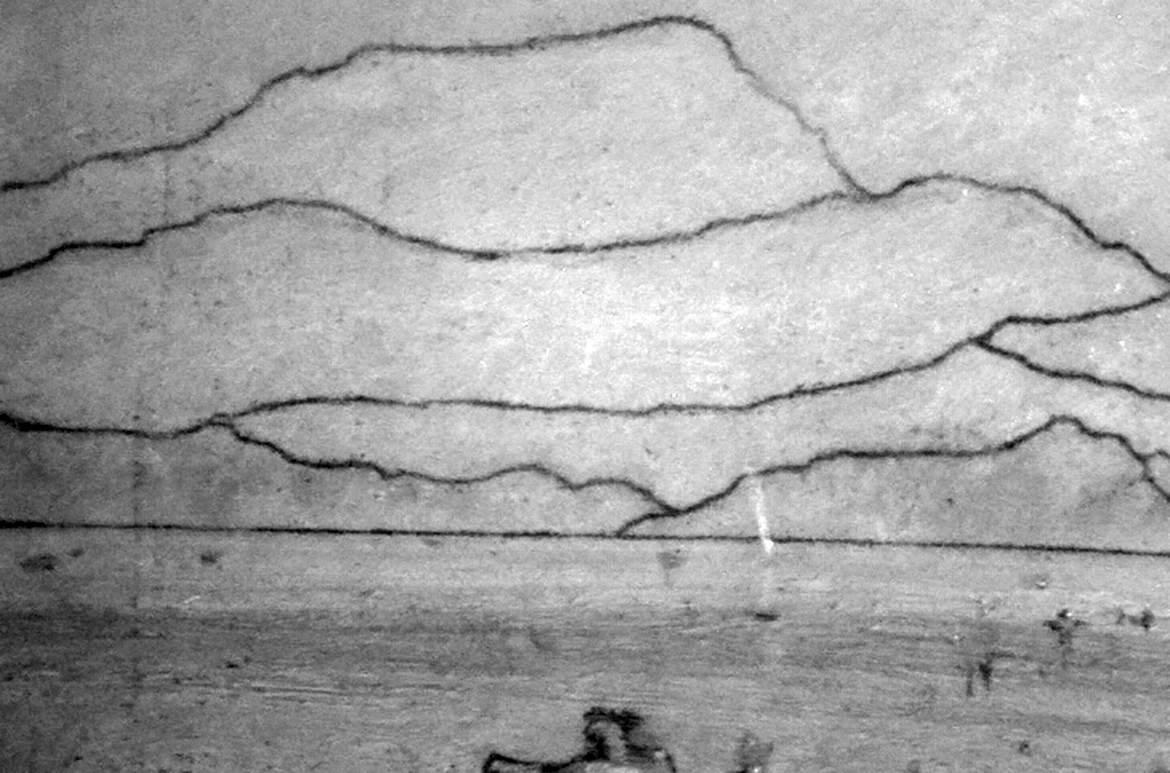 Infrared reflectography (IRR) composite detail of Isaac Walter Jenner’s Queensland natives, the Currigee Oyster Company’s Station, Stradbroke Island, Moreton Bay 1897
Infrared reflectography (IRR) composite detail of Isaac Walter Jenner’s Queensland natives, the Currigee Oyster Company’s Station, Stradbroke Island, Moreton Bay 1897
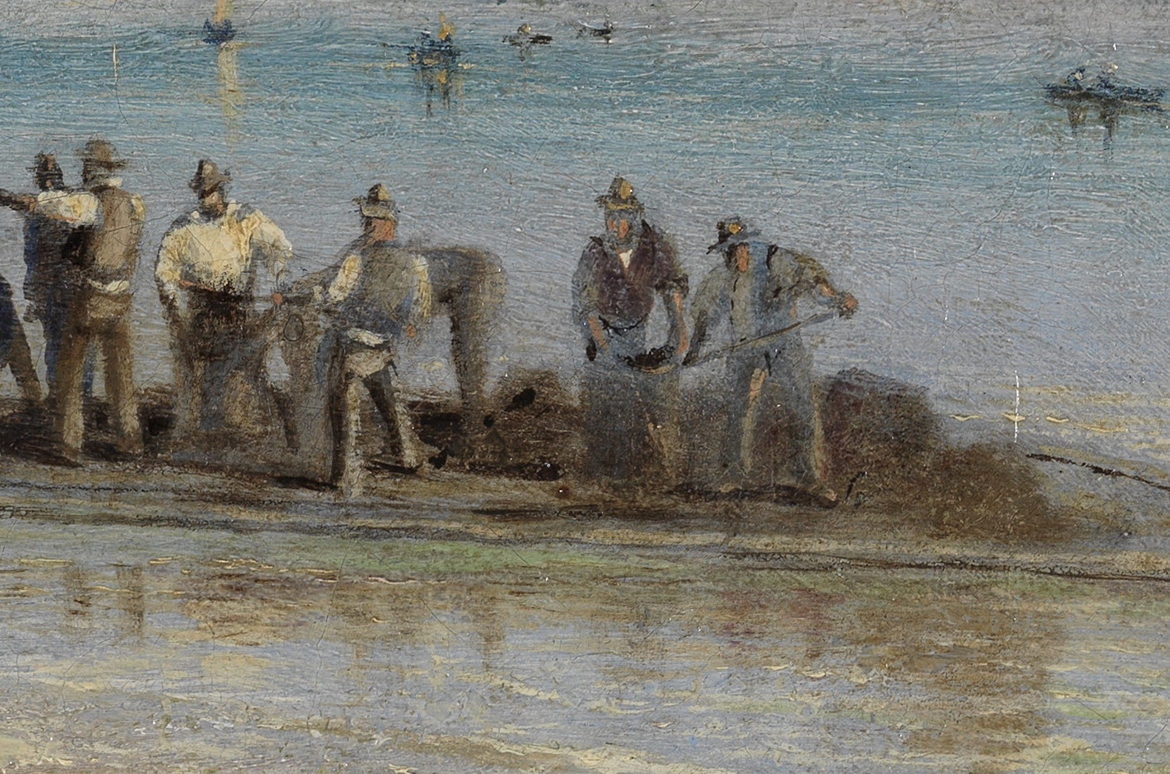 Detail of figures on the raft in Isaac Walter Jenner’s Queensland natives, the Currigee Oyster Company’s Station, Stradbroke Island, Moreton Bay 1897
Detail of figures on the raft in Isaac Walter Jenner’s Queensland natives, the Currigee Oyster Company’s Station, Stradbroke Island, Moreton Bay 1897
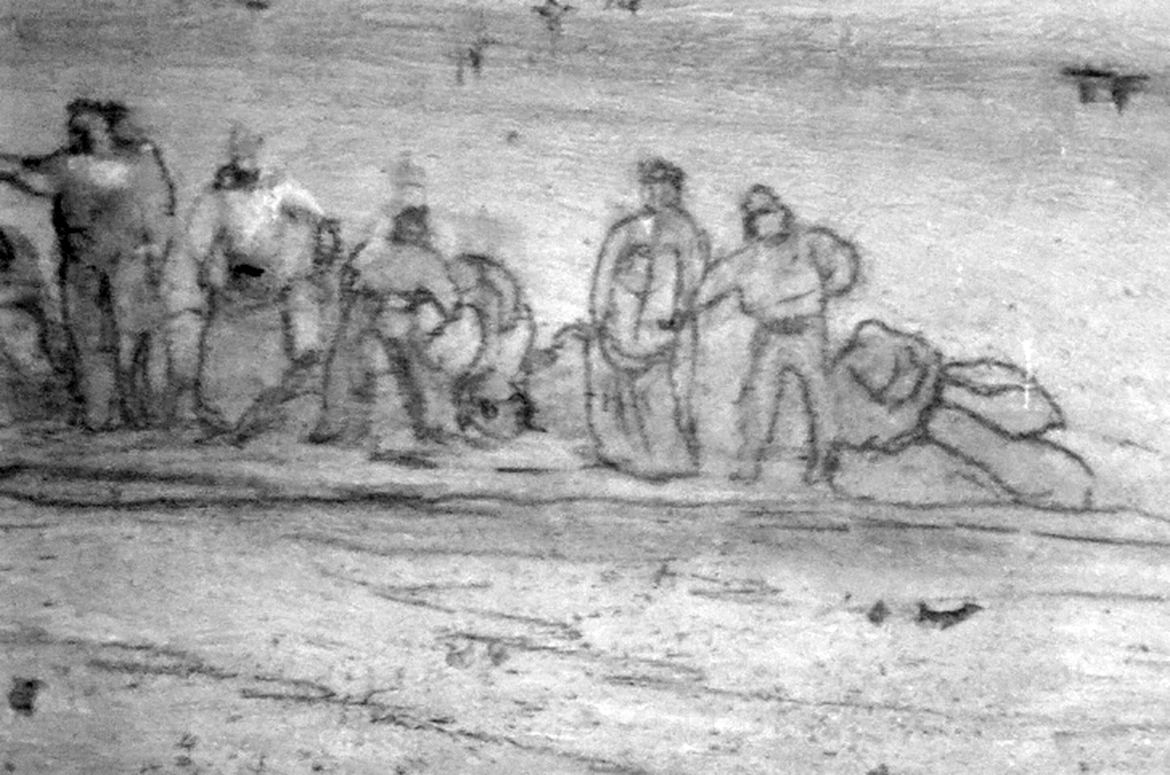 Infrared reflectography (IRR) composite detail of figures on the raft in Isaac Walter Jenner’s Queensland natives, the Currigee Oyster Company’s Station, Stradbroke Island, Moreton Bay 1897
Infrared reflectography (IRR) composite detail of figures on the raft in Isaac Walter Jenner’s Queensland natives, the Currigee Oyster Company’s Station, Stradbroke Island, Moreton Bay 1897
The foliage in Queensland natives, the Currigee Oyster Company’s Station, Stradbroke Island, Moreton Bay 1897 remains sketchy and is not as well defined as it is in Hamilton Reach, Brisbane 1885. It can also be seen that a straight edge has been used to draw the outlines of the architecture and Jenner has also added painted figures in front of the hut that do not appear in the underdrawing. This indicates that the figures were a later addition to the composition.
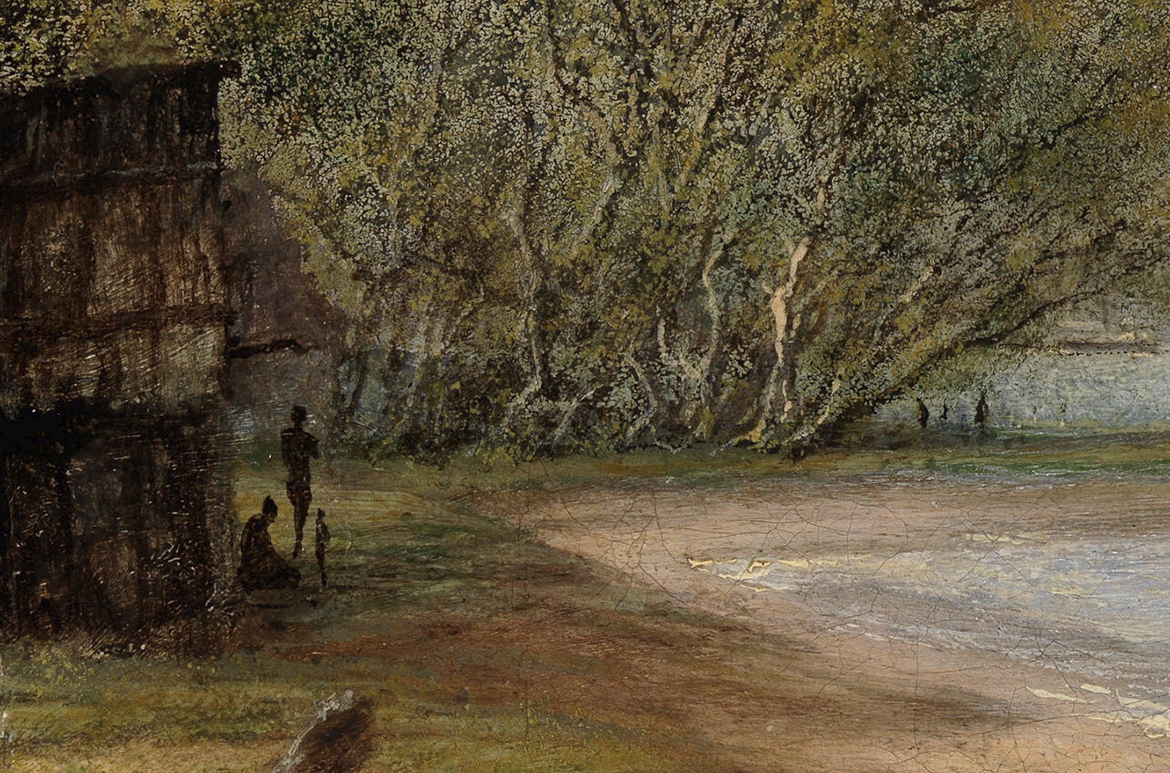 Detail of foliage in Isaac Walter Jenner’s Queensland natives, the Currigee Oyster Company’s Station, Stradbroke Island, Moreton Bay 1897
Detail of foliage in Isaac Walter Jenner’s Queensland natives, the Currigee Oyster Company’s Station, Stradbroke Island, Moreton Bay 1897
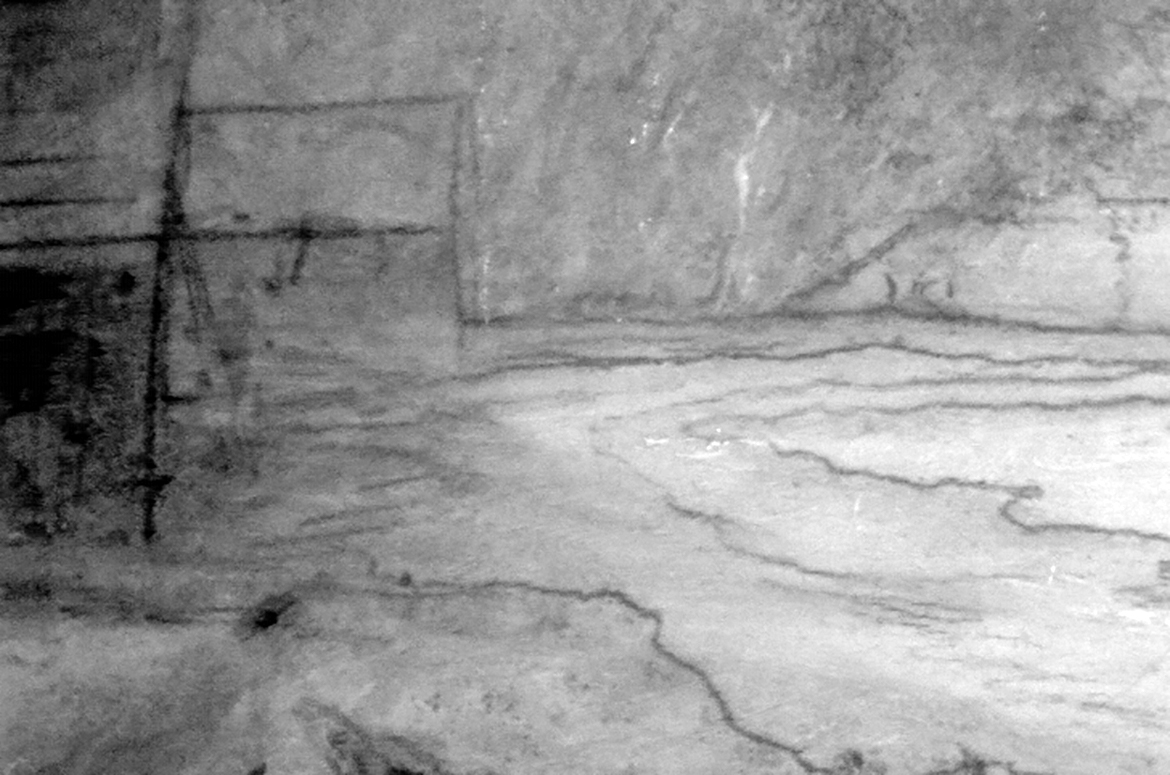 Infrared reflectography (IRR) composite detail of foliage in Isaac Walter Jenner’s Queensland natives, the Currigee Oyster Company’s Station, Stradbroke Island, Moreton Bay 1897
Infrared reflectography (IRR) composite detail of foliage in Isaac Walter Jenner’s Queensland natives, the Currigee Oyster Company’s Station, Stradbroke Island, Moreton Bay 1897
Other design features present in the final painting, but which are not evident in the underdrawing include the fisherman with boat in the foreground. Like the rescaled tree in Hamilton Reach, 1885, this figure appears as a shadowy painted addition under IRR imaging without a drawn outline. Demarcation of the water’s edge runs right through this figure — another indication that he was a later addition.
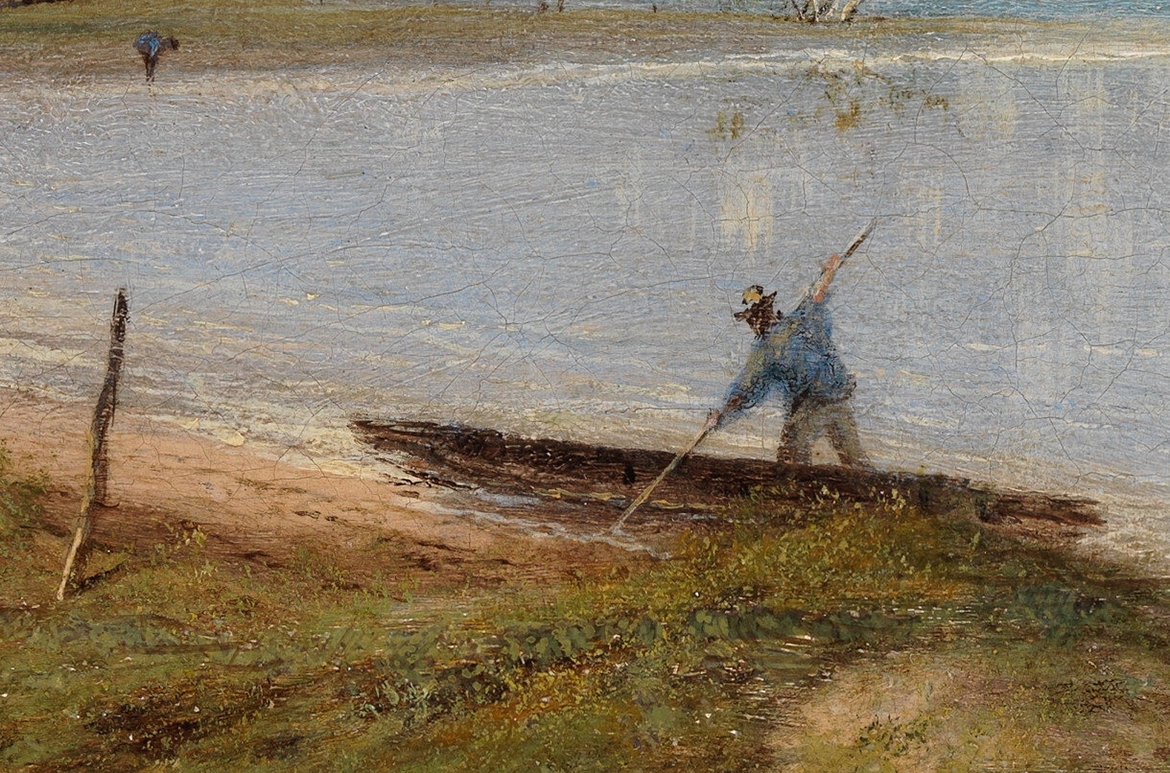 Visible light detail of fisherman with boat in Isaac Walter Jenner’s Queensland natives, the Currigee Oyster Company’s Station, Stradbroke Island, Moreton Bay 1897
Visible light detail of fisherman with boat in Isaac Walter Jenner’s Queensland natives, the Currigee Oyster Company’s Station, Stradbroke Island, Moreton Bay 1897
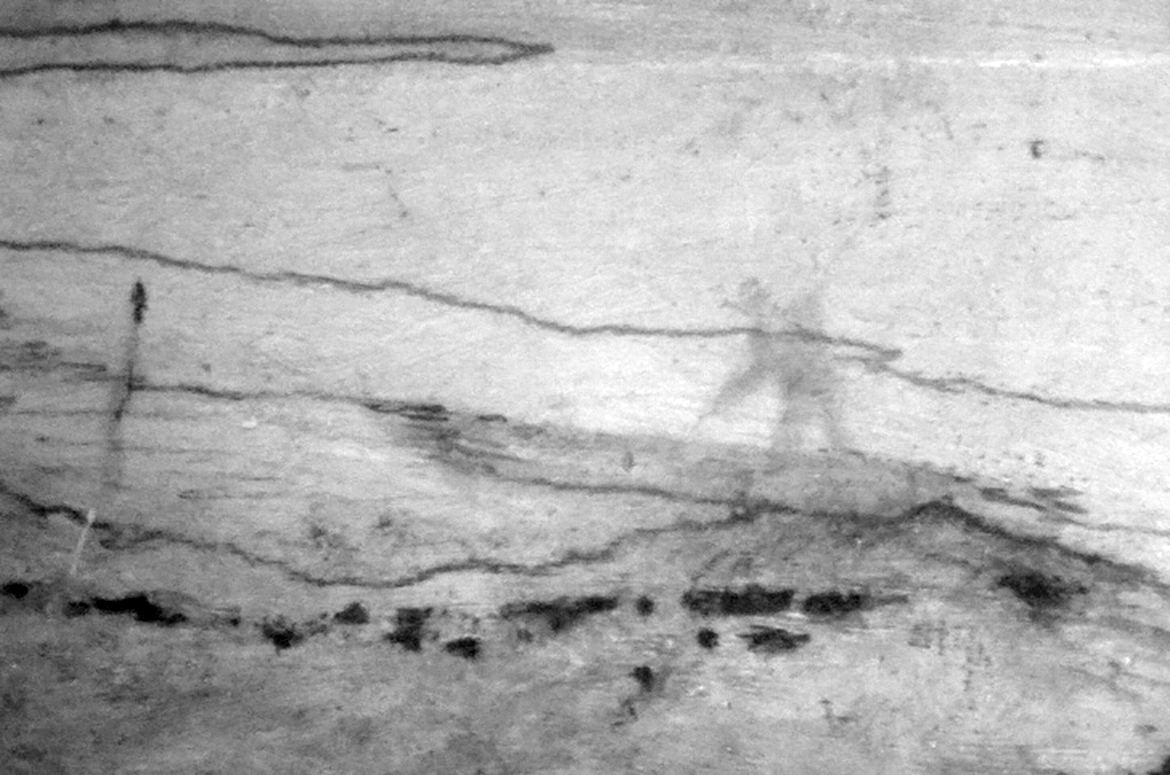 Infrared reflectography (IRR) composite detail of fisherman with boat in Isaac Walter Jenner’s Queensland natives, the Currigee Oyster Company’s Station, Stradbroke Island, Moreton Bay 1897
Infrared reflectography (IRR) composite detail of fisherman with boat in Isaac Walter Jenner’s Queensland natives, the Currigee Oyster Company’s Station, Stradbroke Island, Moreton Bay 1897
‘Brisbane River, Bulimba Reach’ 1894
In Jenner’s Brisbane River, Bulimba Reach 1894 (illustrated), we see another example of a bold confident underdrawing. In this painting, some lines have become visible through thinly painted areas of light-coloured paint. For example, in visible light, underdrawing can be seen through the paint demarcating the outline of the clouds in the sky.
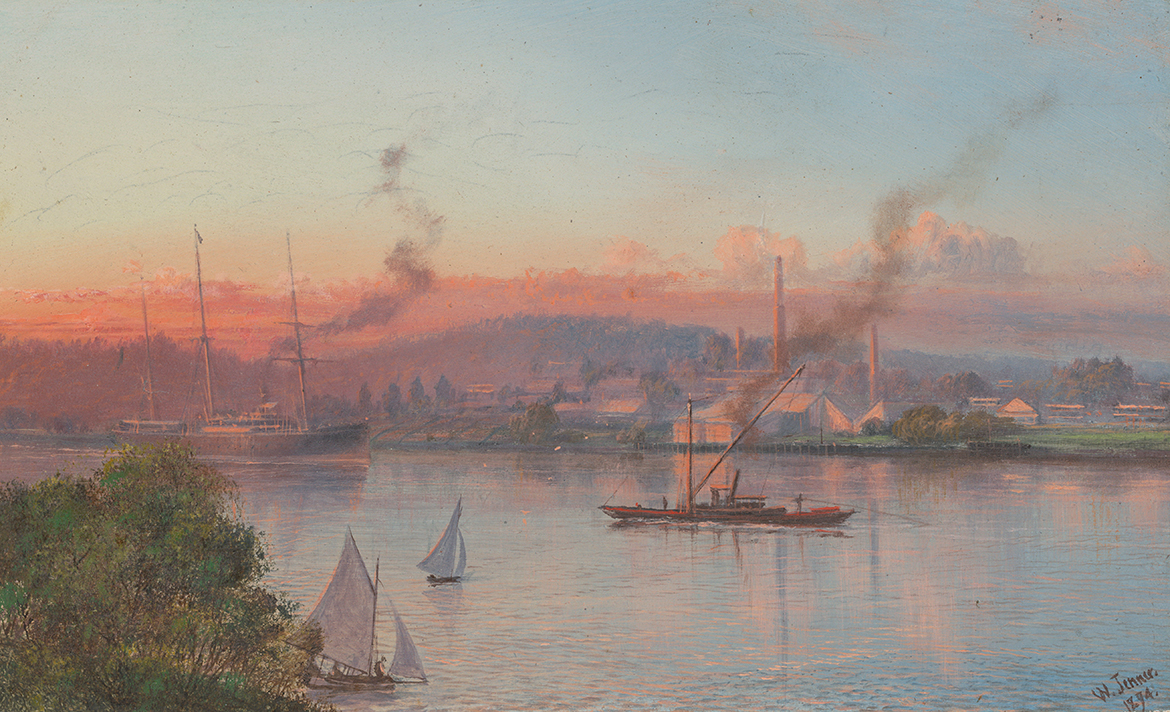 Isaac Walter Jenner, England/Australia 1836-1902 / Brisbane River, Bulimba Reach 1894 / Oil on cardboard / 12.8 x 20cm / Gift from the Estate of Dr Elizabeth (Pat) Marks through the QAG Foundation 2004. Donated through the Australian Government’s Cultural Gifts Program / Collection: Queensland Art Gallery | Gallery of Modern Art
Isaac Walter Jenner, England/Australia 1836-1902 / Brisbane River, Bulimba Reach 1894 / Oil on cardboard / 12.8 x 20cm / Gift from the Estate of Dr Elizabeth (Pat) Marks through the QAG Foundation 2004. Donated through the Australian Government’s Cultural Gifts Program / Collection: Queensland Art Gallery | Gallery of Modern Art
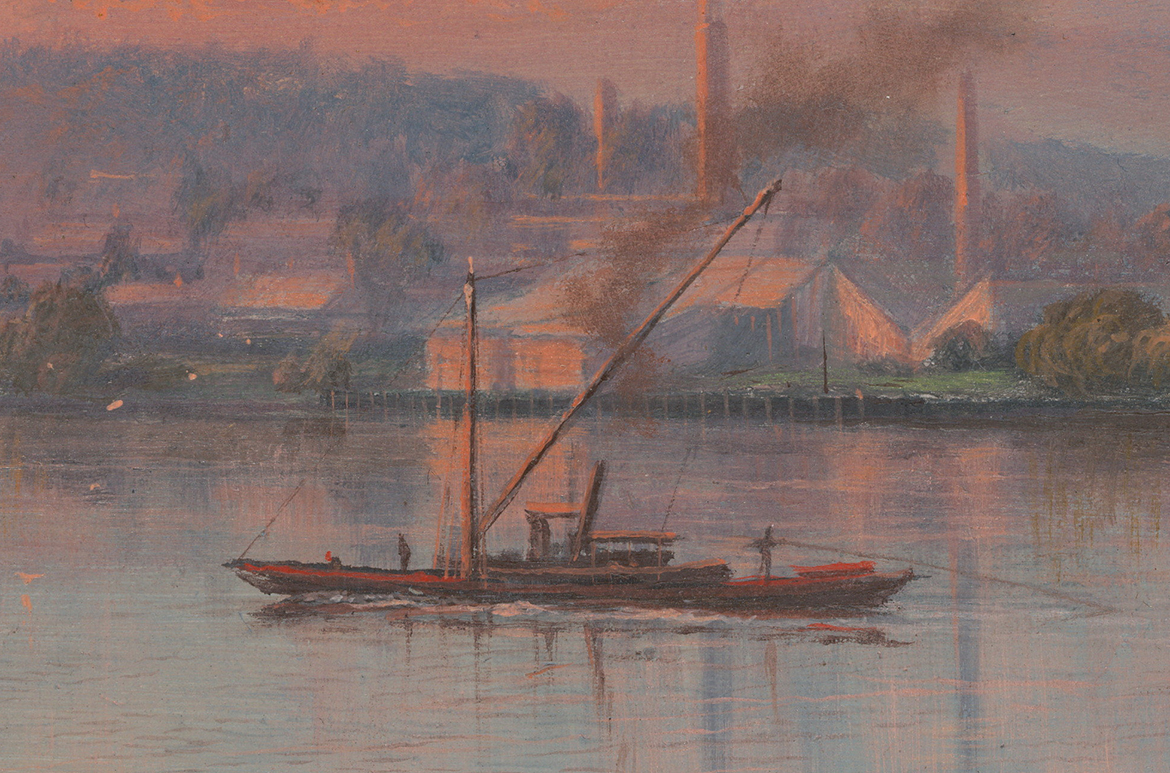 Visible light detail of Brisbane River, Bulimba Reach 1894
Visible light detail of Brisbane River, Bulimba Reach 1894
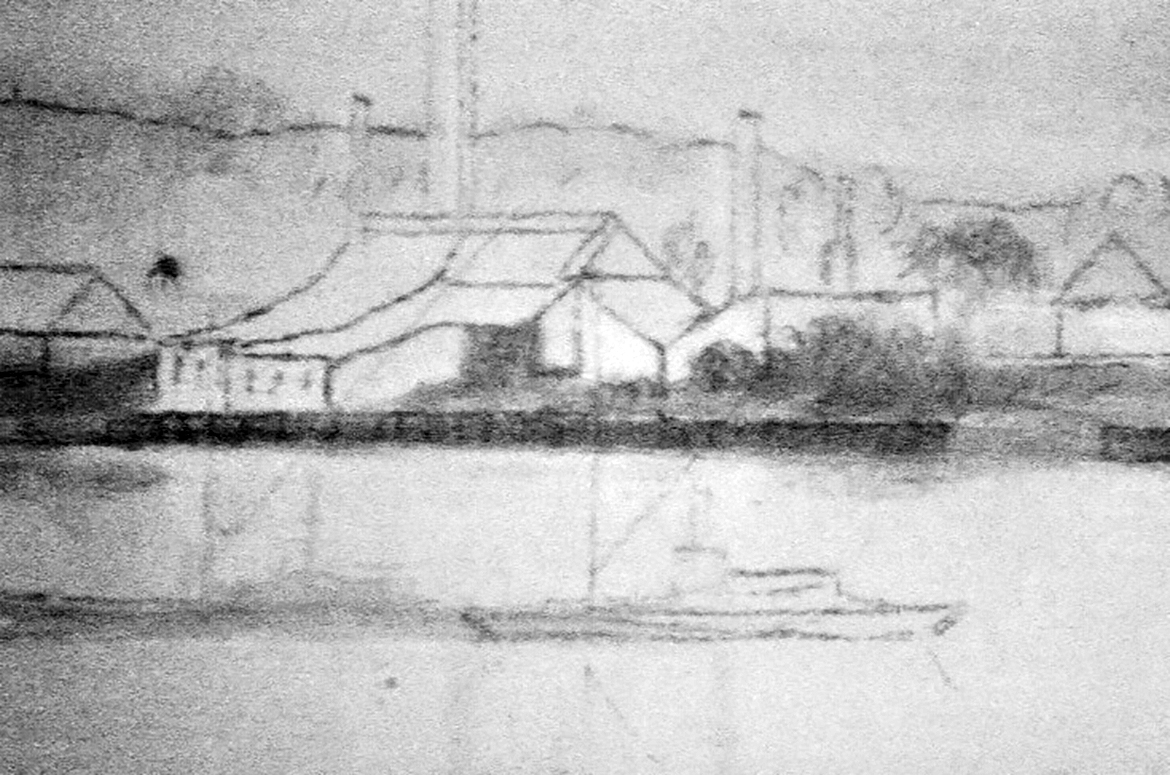 Infrared reflectography (IRR) composite detail of Brisbane River, Bulimba Reach 1894
Infrared reflectography (IRR) composite detail of Brisbane River, Bulimba Reach 1894
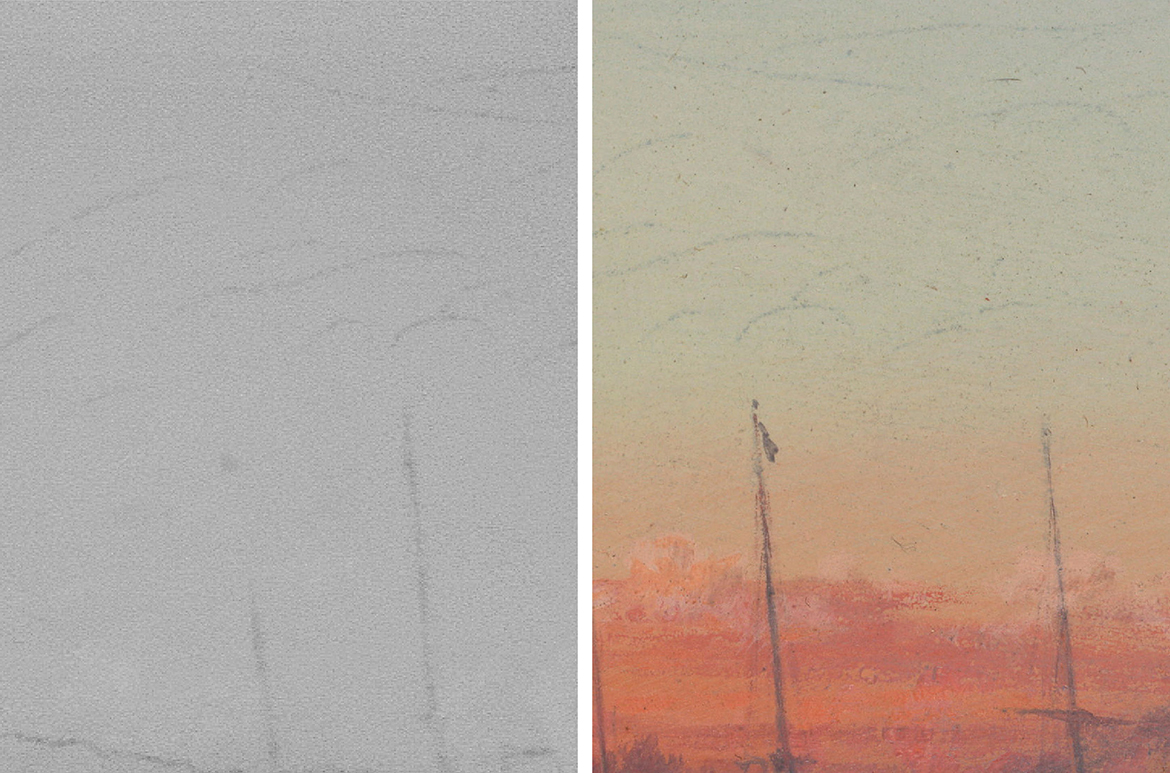 (left) IRR detail showing drawing under the paint (right) visible light detail of the same area in Brisbane River, Bulimba Reach 1894
(left) IRR detail showing drawing under the paint (right) visible light detail of the same area in Brisbane River, Bulimba Reach 1894
Investigation into the painting via cross section by Gillian Osmond, (Conservator, Paintings) also found evidence of the underdrawing layer between the ground and layers of paint. In this cross section (illustrated), the drawing layer can be seen as a broken dark line sandwiched between layers of light-coloured ground below and paint above. Tiny, coloured pigment particles can also be seen in this cross section mixed into the white paint and these pigment particles are what give the paint its pink colour.
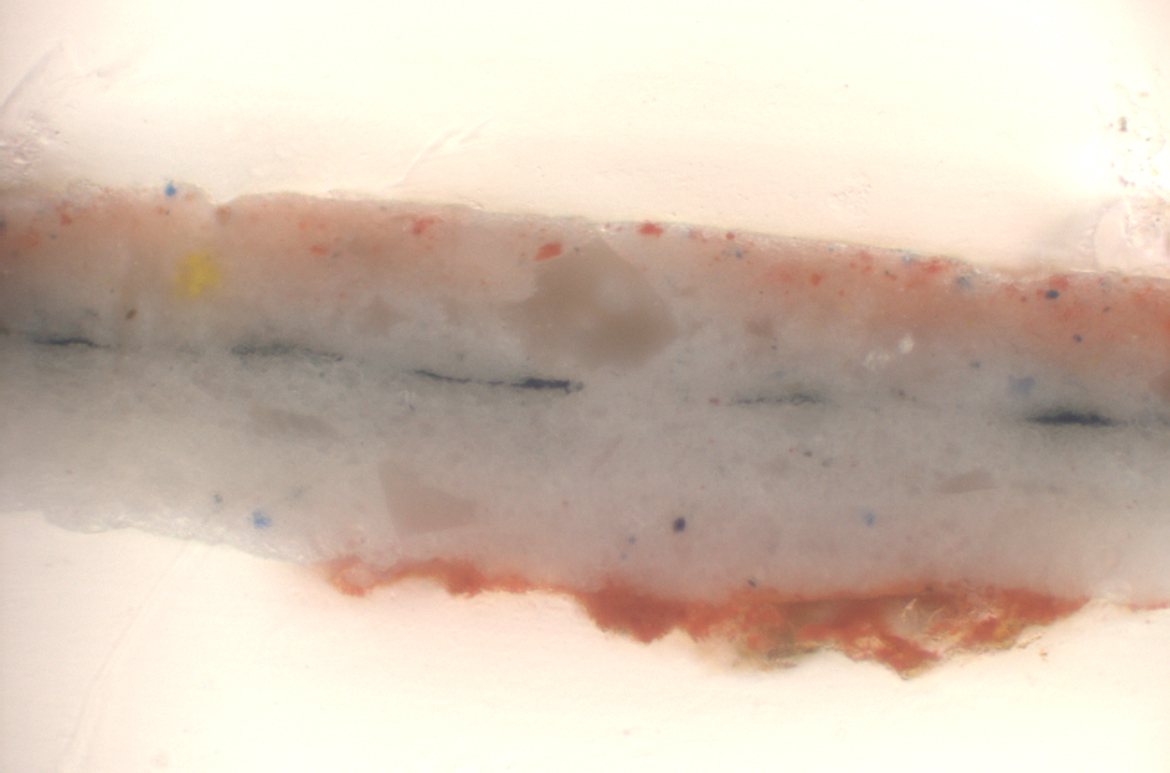 Paint cross section of Brisbane River, Bulimba Reach 1894 prepared by Gillian Osmond, photographed in visible light showing the colours of the paint layers, with the underdrawing layer sandwiched between the ground below and the paint layers above.
Paint cross section of Brisbane River, Bulimba Reach 1894 prepared by Gillian Osmond, photographed in visible light showing the colours of the paint layers, with the underdrawing layer sandwiched between the ground below and the paint layers above.
‘Brisbane River, Garden Reach from near dry dock looking down river’ 1894
Brisbane River, Garden Reach from near dry dock looking down river 1894 (illustrated) shows underdrawing in which Jenner’s deliberately applied lines appear ‘broken’ and perhaps show evidence of the use of an eraser to reduce their density. Fine detail such as the ends of the sawn logs showing age rings and radial splits is also evident in his preparation technique.
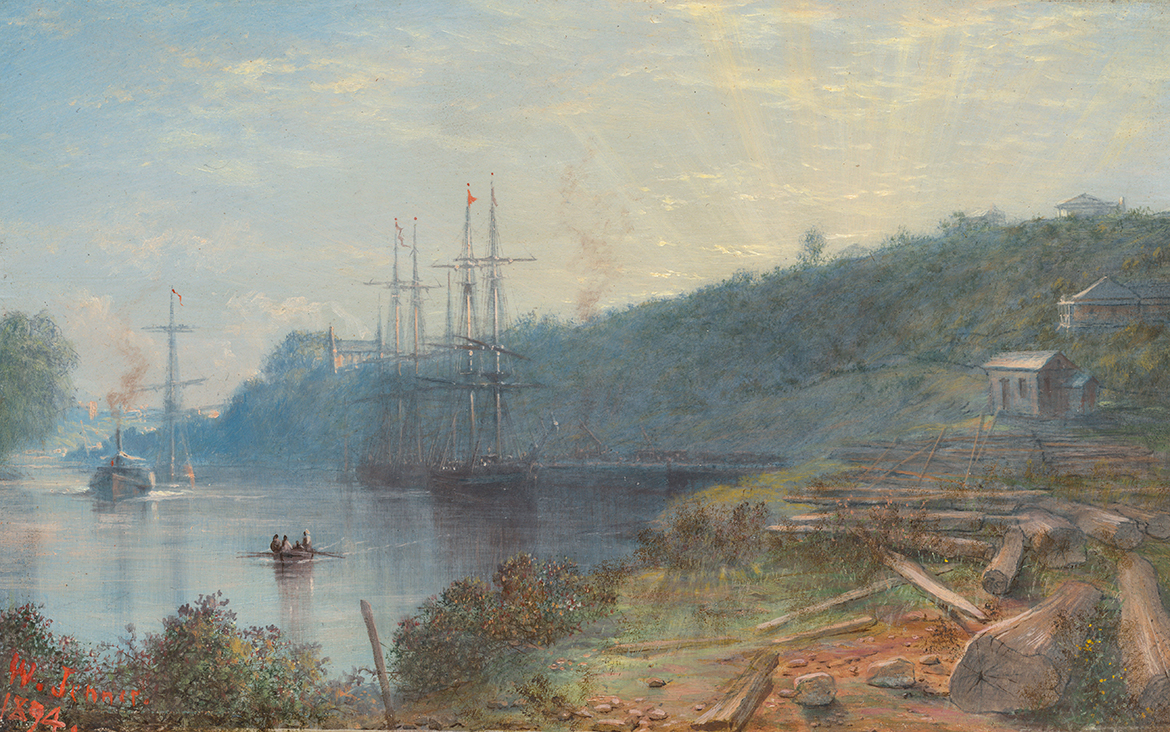 Isaac Walter Jenner, England/Australia 1836-1902 / Brisbane River, Garden Reach from near dry dock looking down river 1894 / Oil on cardboard / 12.8 x 20cm / Gift from the Estate of Dr Elizabeth (Pat) Marks through the QAG Foundation 2004. Donated through the Australian Government’s Cultural Gifts Program / Collection: Queensland Art Gallery | Gallery of Modern Art
Isaac Walter Jenner, England/Australia 1836-1902 / Brisbane River, Garden Reach from near dry dock looking down river 1894 / Oil on cardboard / 12.8 x 20cm / Gift from the Estate of Dr Elizabeth (Pat) Marks through the QAG Foundation 2004. Donated through the Australian Government’s Cultural Gifts Program / Collection: Queensland Art Gallery | Gallery of Modern Art
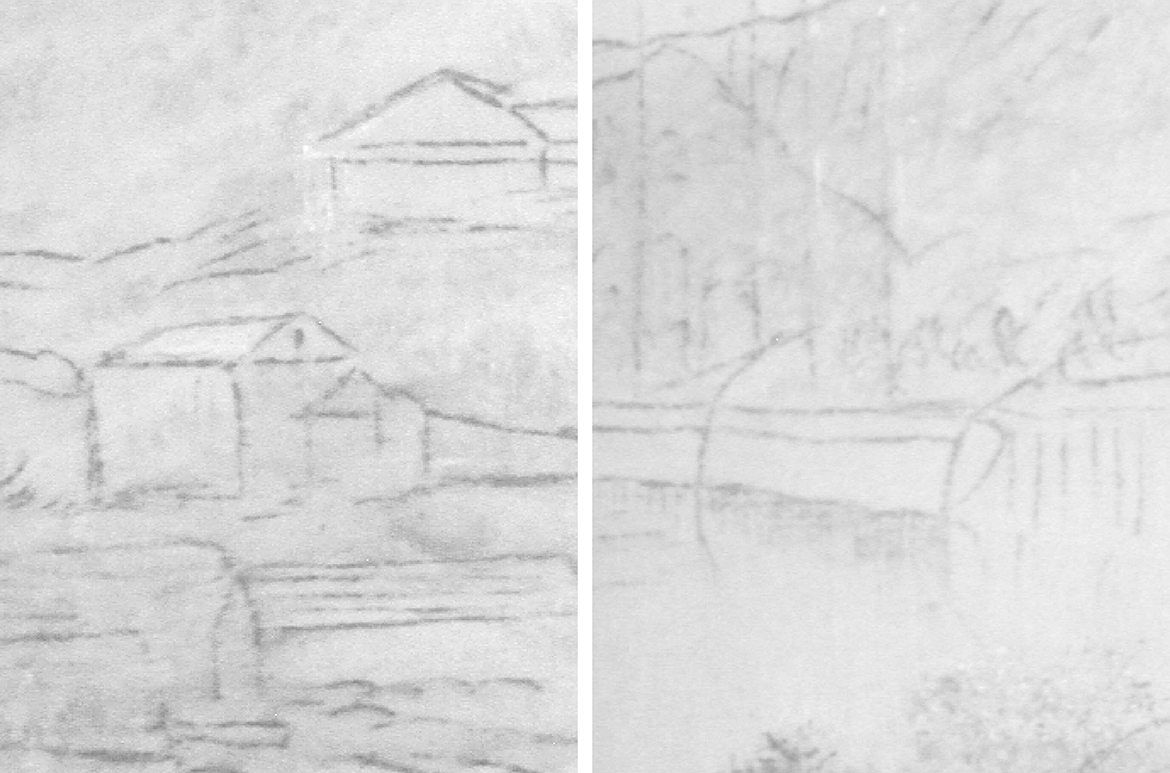 Infrared reflectography (IRR) details of Brisbane River, Garden Reach from near dry dock looking down river 1894 where applied lines appear ‘broken’
Infrared reflectography (IRR) details of Brisbane River, Garden Reach from near dry dock looking down river 1894 where applied lines appear ‘broken’
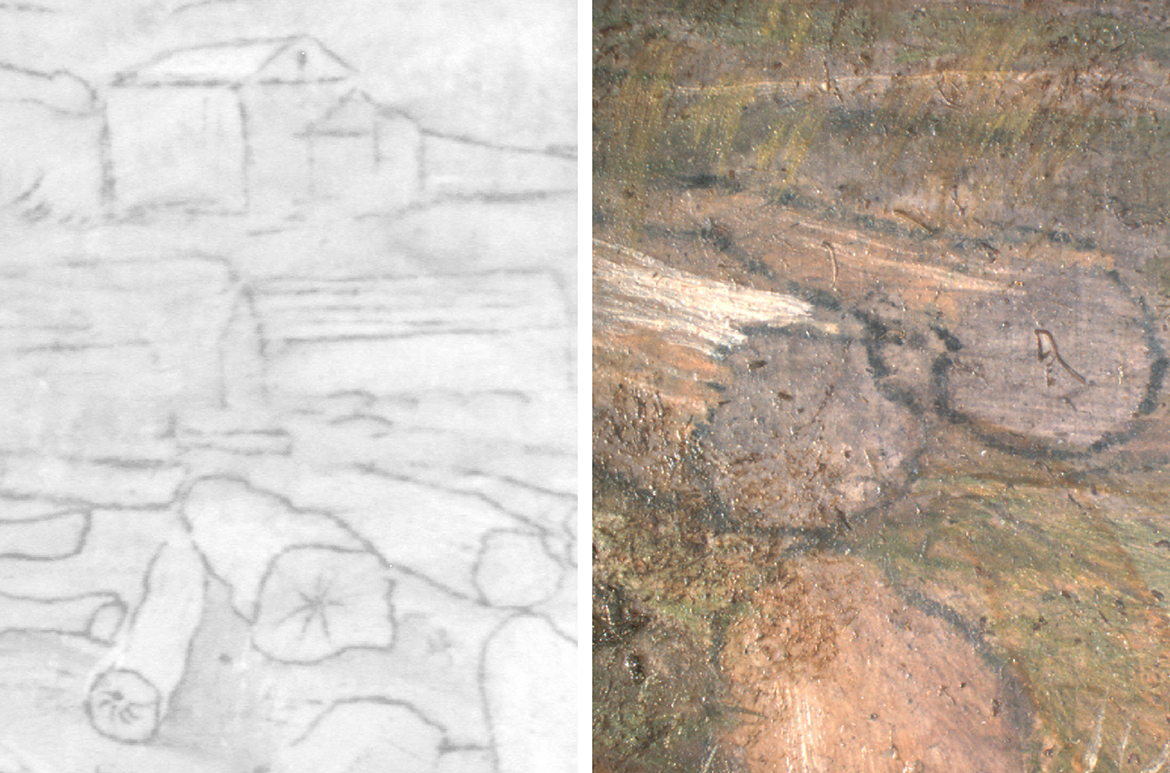 (left) Infrared reflectography (IRR) detail (right) visible light detail of the same area in Brisbane River, Garden Reach from near dry dock looking down river 1894 (right)
(left) Infrared reflectography (IRR) detail (right) visible light detail of the same area in Brisbane River, Garden Reach from near dry dock looking down river 1894 (right)
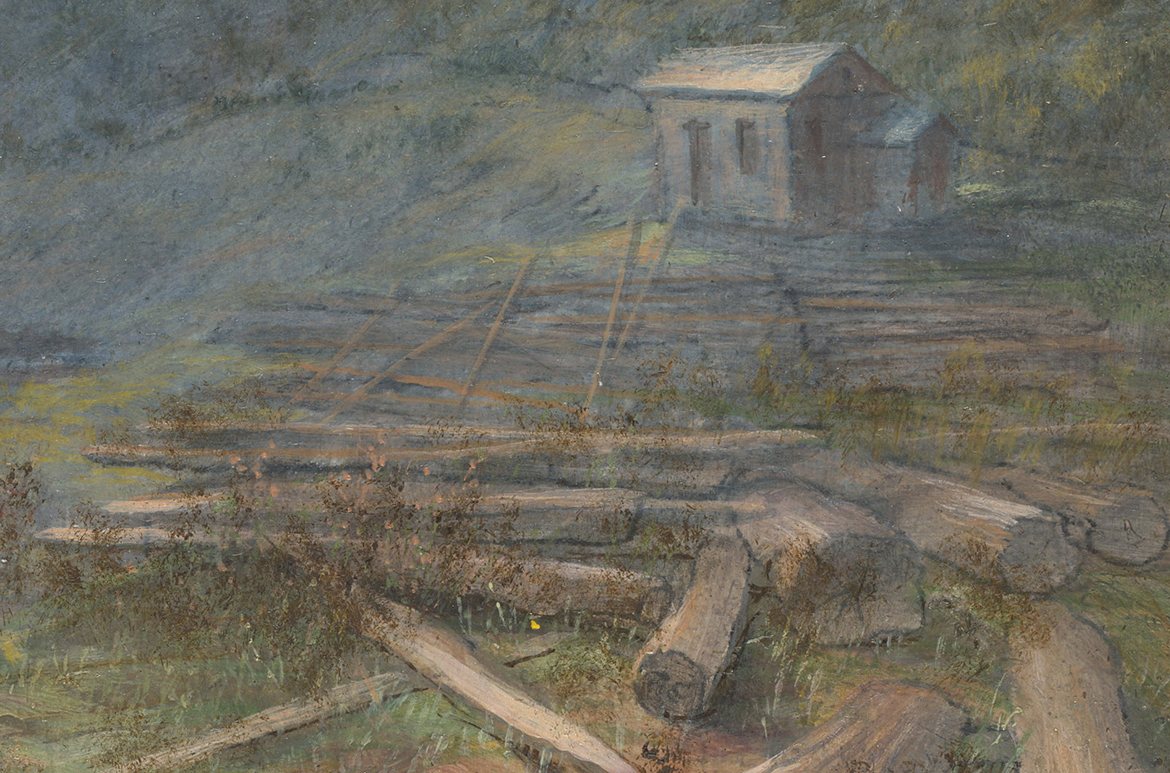 Visible light detail of Brisbane River, Garden Reach from near dry dock looking down river 1894
Visible light detail of Brisbane River, Garden Reach from near dry dock looking down river 1894
‘HMS Victory at Portsmouth’ c.1881
HMS Victory at Portsmouth 1881 (illustrated) shows evidence of a grid — visible under IRR imaging in the top right corner of the painting — this usually means that the underdrawing was copied from a sketch at a different scale. The underdrawing is also precise with emphasis on perspective and the lines appear to have been ruled using a straight edge. This demonstrates planning of the complicated patterns of masts and rigging and the detailed features of HMS Victory, including its receding sets of windows/portholes.
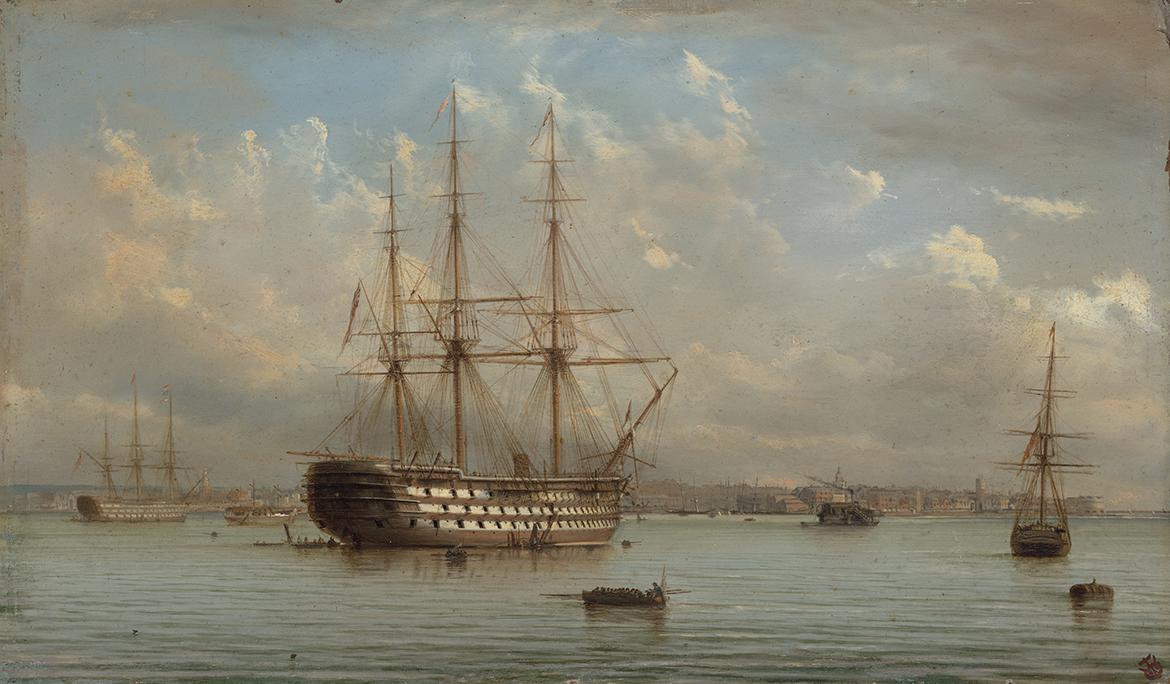 Isaac Walter Jenner, England/Australia 1836–1902 / HMS Victory at Portsmouth c.1881 / Oil on academy board / 22.6 x 39.2cm / Gift of Merle Melrose Edmonds in memory of her great-grandfather, Isaac Walter Jenner, through the QAGOMA Foundation 2021 / Collection: Queensland Art Gallery | Gallery of Modern Art
Isaac Walter Jenner, England/Australia 1836–1902 / HMS Victory at Portsmouth c.1881 / Oil on academy board / 22.6 x 39.2cm / Gift of Merle Melrose Edmonds in memory of her great-grandfather, Isaac Walter Jenner, through the QAGOMA Foundation 2021 / Collection: Queensland Art Gallery | Gallery of Modern Art
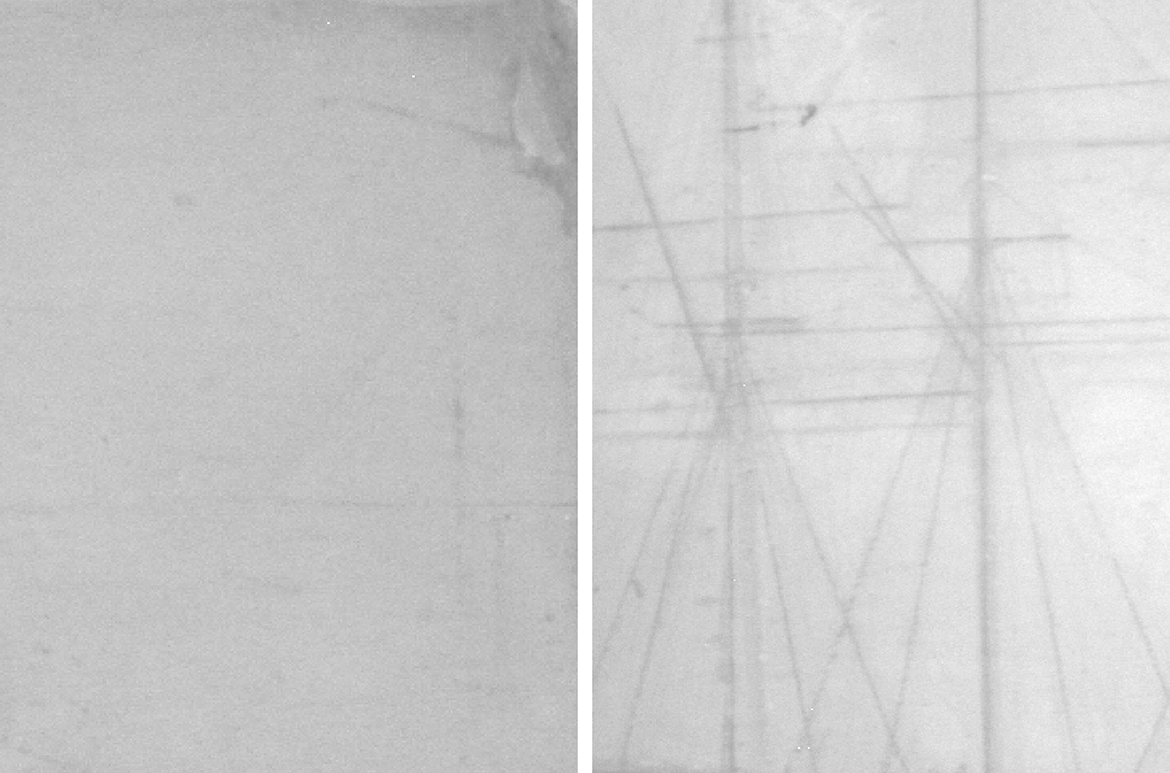 (left) Infrared reflectography (IRR) detail showing the use of a grid lines used to scale and transfer the underdrawing; (right) lines showing rigging that appear to have been ruled using a straight edge in HMS Victory at Portsmouth c.1881
(left) Infrared reflectography (IRR) detail showing the use of a grid lines used to scale and transfer the underdrawing; (right) lines showing rigging that appear to have been ruled using a straight edge in HMS Victory at Portsmouth c.1881
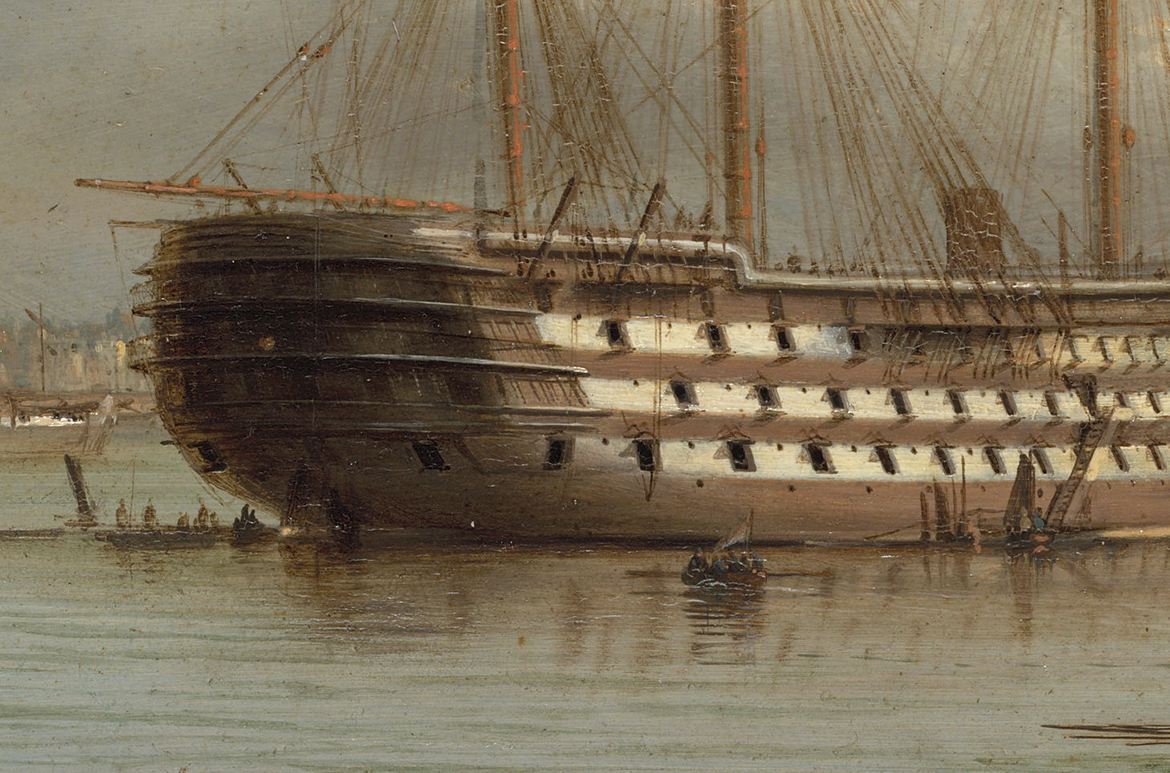 Visible light detail of HMS Victory at Portsmouth c.1881
Visible light detail of HMS Victory at Portsmouth c.1881
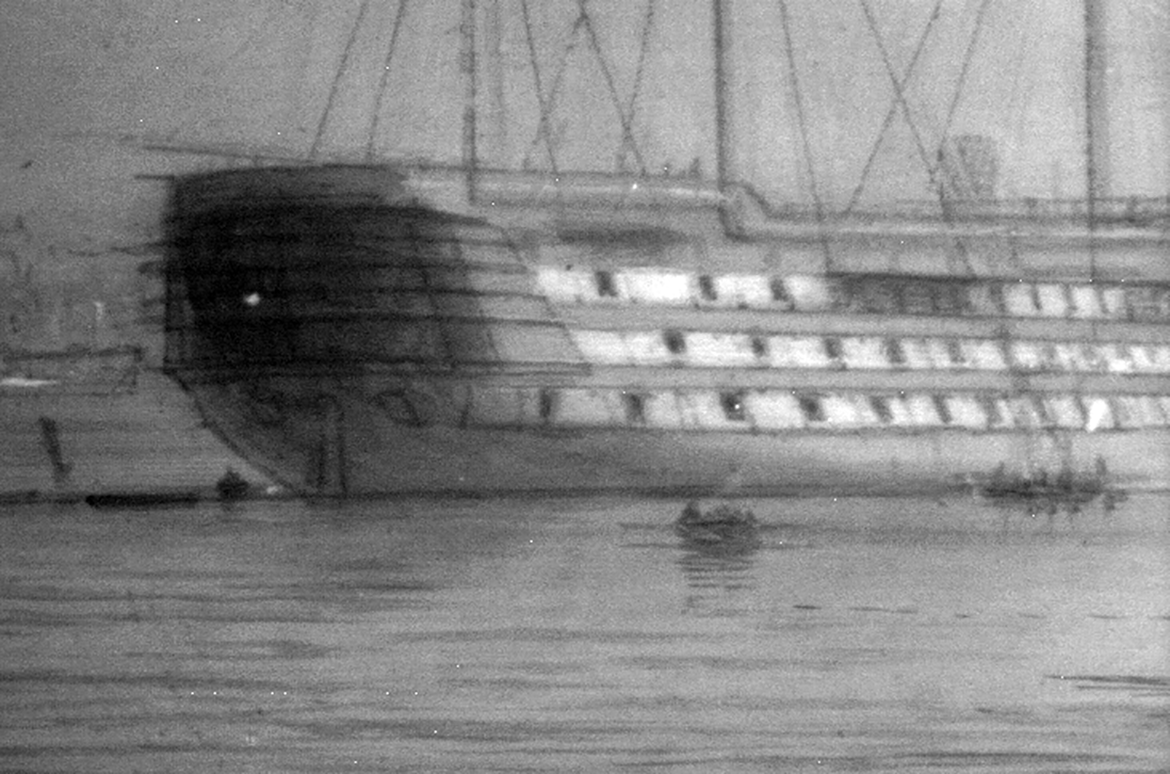 Infrared reflectography (IRR) detail of HMS Victory at Portsmouth c.1881
Infrared reflectography (IRR) detail of HMS Victory at Portsmouth c.1881
Anne Carter is Conservator, Paintings, QAGOMA
Endnote
1 How we see underdrawing – about infrared imaging.
If drawn in a carbon-based medium such as charcoal which absorbs heat (infrared radiation), underdrawing can be revealed beneath layers of paint using an infrared camera. The infrared camera has a detector sensitive to heat. Images produced through infrared camera collection are black and white and look like the drawings themselves. They are often grainy and low resolution due to the capabilities of the infrared cameras.
(IRR Images captured and compiled using a Hamamatsu Vidicon Infrared camera by Anne Carter, Mandy Smith, Natasha Harth, Gillian Osmond, Rebecca Negri, Ruby Awburn, Emily Kelleher)
On display in the exhibition ‘Isaac Walter Jenner: A Feeling for Light’ at the Queensland Art Gallery (G14) from 2 September 2023 – 28 January 2024.
#QAGOMA


